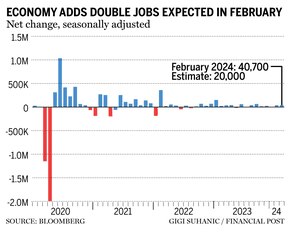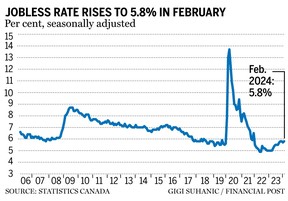Wage growth still too high to bring inflation down
Article content
The Canadian economy produced double the number of jobs forecasted by analysts, but the unemployment rate rose to 5.8 per cent in February from 5.7 per cent in March as population growth continued to outpace the employment market, according to Statistics Canada’s latest Labour Force Survey.
Here’s what economists are saying about what the figures mean for the economy, the Bank of Canada and interest rates.
Advertisement 2
Article content
Article content
Bryan Yu, Central 1
“For inflation and interest rate watchers, comfort could be found in signs of rising labour market slack and moderation in wage growth as population growth swamped hiring,” Bryan Yu, chief economist at Central 1 Credit Union said.
Wage growth slowed to five per cent year over year in February from 5.3 per cent in January, while the number of people looking for work rose by 76,400, much more than the 41,000 new jobs created.
The employment rate fell in February to 61.5 per cent, a fifth consecutive drop and the rate is now at its lowest level since October 2021, Yu said in a note.
“Mixed signals from the labour market of robust employment growth and softening labour market conditions will be challenging for the Bank of Canada, but signs persist of a cooling market driven by the swelling labour supply,” he said. “This should moderate wage growth and inflation pressures, and we maintain a call for a June rate cut.”
Olivia Cross, Capital Economics
The Bank of Canada should be relieved by the latest jobs report, including the signs of slack in the workforce since it means more people are looking for work than jobs available, and the continued slowdown in wage increases, said Olivia Cross, North America economist at Capital Economics Ltd.
Article content
Advertisement 3
Article content
The central bank’s statement accompanying its interest rate hold this week indicated wage growth is still on its radar.
Average hourly wages grew five per cent year over year in February, slowing from 5.3 per cent the month before.
That is still too high to bring inflation down to the bank’s two per cent target, Cross said.
“While the bank will need to see wage growth soften further before it pivots to rate cuts, we suspect that weaker labour demand and renewed gains in labour supply will keep wage growth on that downward trend,” she said in a note.

Tu Nguyen, RSM Canada
“The job market is tipping into an employer’s market,” Tu Nguyen, an economist at accounting firm RSM Canada LLP, said in a note.
He said hourly wage growth for permanent employees — a different measure from the one cited by Statistics Canada — slowed to 4.9 per cent, falling below five per cent for the first time in a year.
That, coupled with a climbing unemployment rate, shows more disinflation is on the way, he said, something the Bank of Canada has made clear it needs to see before it feels confident it can start cutting interest rates.
Advertisement 4
Article content
Still, the economy added thousands of new jobs, “a sign of remaining steam that could keep the economy afloat for a few more months,” Nguyen said, but, ultimately, the jobs report didn’t move the rate-cut needle.
“February’s job report did little to sway the Bank of Canada’s likelihood to begin cutting rates in June,” he said.
Andrew Grantham, CIBC Capital Markets
There was nothing in the jobs data that will push the Bank of Canada to act sooner on cutting interest rates, said Andrew Grantham, an economist at CIBC Capital Markets.
“The Bank of Canada appeared in no rush to start cutting interest rates earlier in this week, and today’s data will do little to speed the process up,” he said in a note, adding that the economy doubled the number of positions forecast with all the hiring coming in the form of full-time jobs.
Grantham said the rising unemployment rate is simply offsetting an “unexpected” drop to 5.7 per cent in January. But wage growth is still too high for central bank officials’ liking, he said.
“Overall, there is still evidence from today’s data that labour market conditions are loosening, but only very gradually and not in a way that demands an imminent reduction in interest rates,” Grantham said. “We continue to forecast a first reduction at the June meeting.”
Advertisement 5
Article content

Nathan Janzen, Royal Bank of Canada
The gain in jobs during February provides proof the Canadian economy continued to expand in the first quarter of 2024, said Nathan Janzen, assistant chief economist at the Royal Bank of Canada, as full-time positions and hours worked grew, although the bank estimates per-person output shrank for the seventh consecutive quarter.
Still, he thinks there are plenty of signs that the job market is “rebalancing” away from employees to employers, including data showing permanent layoffs are up 32 per cent. He also said job vacancies are down 25 per cent from levels a year ago.
“The rebalancing is shifting bargaining power in wage negotiations away from workers,” Janzen said in a note.
Recommended from Editorial
-

Job gains double expectations, unemployment rate ticks higher
-

What senior bank executives are saying about the economy
He thinks the unemployment rate will continue to climb in the first half of the year in tandem with slowing growth per capita. Based on this data, he thinks a first rate cut in June still makes sense.
“We continue to expect the combination of a softening economic backdrop and slowing inflation pressures will allow the BoC to pivot to gradual interest rate cuts starting in June,” Janzen said.
• Email: gmvsuhanic@postmedia.com
Article content
What economists say about Canada’s February jobs data
2024-03-08 17:14:20






